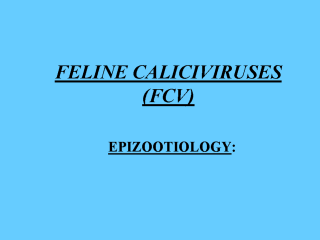| front |1 |2 |3 |4 |5 |6 |7 |8 |9 |10 |11 |12 |13 |14 |15 |16 |17 |review |
 |
Present in about 50% of cats with upper respiratory disease. Clinical disease often
seen in the acute form in young kittens when passive immunity declining. Clinical disease
rare in cats over 1 year due to active immunity. Most common in dense cat populations (catteries, breeding colonies & multiple cat households). Infections with different strains probably occur throughout life sub-clinically; an important source of infection. Unlikely that many cats escape infection. FCV can exist in many cat populations without causing serious problems. Up to one third of adult cats remain persistently infected (carriers), shedding virus asymptomatically more or less continuously from oropharynx for several years; high-, medium-, or low-level excretors. Persists in tonsil; sometimes chronic oral lesions. Carrier state may be self-limiting or life-long;direct contact with naso-lacrimal or oral secretions probably the primary means of virus spread. Worldwide infection. |